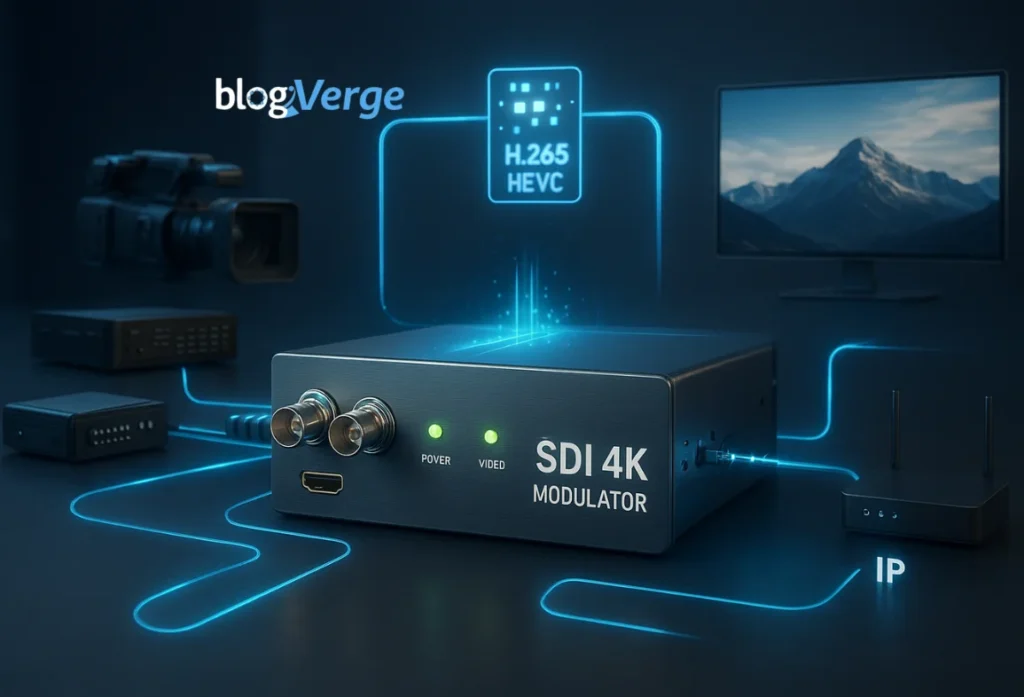Such a visual experience has enhanced the way the world sees images, and the SDI 4K Modulator is at the core of this revolution. It is the best bridge between professional 4K SDI and everyday display systems, enabling you to deliver your 4K content to the audience in all its gorgeous clarity and detail, with zero signal-to-noise loss.
An SDI 4K Modulator receives your professional video stream, whether it is a camera feed, switcher feed, or media server feed, and converts it to a format that can be broadcast, streamed, or distributed internally. It implies that regardless of whether you are operating a hotel TV network, live event venue, or production studio, your audience can see all the pixels in high detail.
The SDI 4K Modulator is the pulse of 4K video delivery. It encodes and propagates video streams within standard RF or IP networks, keeping the picture crisp, color accurate, and in time with the source content to display.
Table of Contents
How an SDI 4K Modulator Works
An SDI 4K Modulator is similar to a translator. It accepts uncompressed 4K SDI video inputs, encodes them with the help of such advanced codecs as H.265 (HEVC), and modulates the signal to either RF or IP. This facilitates better movement of 4K video over the coaxial cables or network systems without loss of quality.
The Input Stage
The device supports 12G-SDI as an input, enabling the transmission of 1 cable full 4K 60 fps video. This input can be in the form of cameras, mixers, or playback servers. Flexibility is also provided by having some modulators with HDMI or IP inputs.
Encoding and Compression
Then, the SDI 4K Modulator codes the signal in HEVC or H.264. HEVC compression saves bandwidth without compromising on the breathtaking image quality. This enables streaming 4K content over even old infrastructure without stutter and distortion.
Modulation and Output
Once coded, the modulator converts the digital signal into either an RF broadcasting format, such as DVB-T, QAM, or ATSC, or a digital distribution format, such as IP streams. This is why it is suitable for applications of hybrid systems where 4K is being sent to both the old TV and the new streaming site simultaneously.

Key Features of the SDI 4K Modulator
12G-SDI Compatibility
SDI 4K Modulators are now available with 12G-SDI (single-cable 4K), eliminating the need for multiple links between 4K and 2K setups and simplifying them.
Dual RF/IP Output
Top models deliver RF outputs as well as IP outputs, which facilitates the deployment flexibility in both broadcast and IP-based implementations.
Advanced Codecs
HEVC (H.265) is provided, which guarantees efficient compression while maintaining image clarity and consuming less bandwidth.
Ultra-Low Latency
Latency is essential in real-time applications such as sports or concerts. A large number of SDI 4K Modulators provide close to real-time transmission within 100 milliseconds.
Remote Monitoring
By using web-based control interfaces, users have the option to monitor bitrates, signal strength, and encoder performance remotely.

The reason why you should have an SDI 4K Modulator
It is not merely a matter of considering technology to use an SDI 4K Modulator, but the integrity of your visual communication. Whether you are a broadcaster, an educator, or an AV integrator, this device will ensure that your content remains brilliant for a long time.
TV Networks and Cable Networks
TV networks use modulators to transform professional SDI feeds into RF channels for mass-scale distribution. It is through this platform that 4K sports and entertainment channels are available at homes around the world.
Hospitality and Hotels
Hotels are installing SDI 4K Modulators, enabling them to deliver high-quality 4K video to all rooms via their existing coaxial networks without the need for additional rewiring.
Medical and Educational Use
The 4K clarity is essential in hospitals and universities. These modulators are used in surgical imaging to provide clear images with negligible latency, but also in remote lectures.
The Procedure for selecting the correct SDI 4K Modulator
The purpose determines the ideal SDI 4K Modulator to use. Here’s what to consider:
Input and Output Options
Ensure that you require 12G-SDI, HDMI, or IP input. Also, make sure the format of broadcast in your area (ATSC, DVB-T, or QAM).
Codec Support
HEVC is a necessity in bandwidth efficiency. H.264 compatibility means that there is a broader level of device adoption.
Channel Capacity
If you plan to distribute multiple 4K feeds, consider a multichannel module chassis.
Latency and Quality
Select devices with low latency, less than 100ms, for real-time occurrences and ensure that the video output is stable.
Brand and Reliability
Well-known brands such as Thor Broadcast, Vecoax, and ProVideo Instruments provide the best after-sales service and software upgrades.
Advantages of SDI 4K Modulators
1. Crystal-Clear Picture Quality: Does not lose native 4K resolution and bright colors.
2. Flexibility: Radiofrequency and Internet outputs.
3. Dependability: Constructed to work 24/7 in a professional environment.
4. Low Price: It utilizes available coaxial infrastructure.
5. Scalability: Addition of more channels becomes easy.
6. Low Latency: Real-time performance that is suitable for live events.
7. Future-Proofing: Prepared to go 8K.
Common Mistakes to Avoid
SDI 4K Modulators also allow simple errors to be made by even advanced users. These are avoidable to guarantee maximum performance:
Low-quality SDI cables may lead to frame drops or pixel noise.
Note: This is optional, as the choice of broadcast format compatibility (e.g., ATSC, DVB-T, or QAM) does not affect the outcome, provided it aligns with your country’s standards.
Missing firmware updates – the manufacturers frequently issue fixes for bugs in the encoding process or performance enhancements.
Ventilation is also a factor to consider, as 4K encoding produces heat, which is why it is always better to have good ventilation.
Latency should not be checked; instead, timing should be tested in live systems to ensure there are no audio-video sync problems.
Conclusion
The SDI 4K Modulator is not just any device, but the key to the purity of your 4K content. Whether it’s live casts or in-house video networks, it ensures that every pixel of your creation reaches the audience with optimal detail.
With the advancement of video resolution and distribution networks, the reliable SDI 4K Modulator is no longer a choice, but a must. By choosing the right one, you will experience fewer headaches, perform better, and enjoy the satisfaction of knowing your visuals are being viewed as intended.
So, whether you are investing in a broadcast engineer, an AV manager at a hotel, or even a digital media professional, you are investing in an SDI 4K Modulator as the means of adding some sparkles of the real 4K.
FAQs
Q1: Are we living events properly?
Ans: Yes, More than 4000 SDI Modulators will be competent enough to provide ultra-low latency, which is suitable for real-time operation.
Q2: Does it offer a large number of 4K channels?
More advanced versions also support multiple 4K streams at once, which is best in the business.
Q3: Does it support HEVC (H.265)?
The majority of modern SDI 4K modulators cannot accommodate high-quality 4K at lower bitrates.

